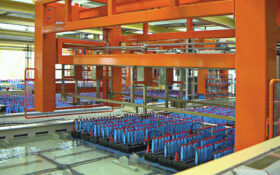Scientists in the US have pushed the limits of a zinc-manganese oxide battery to the point where the chemistry can match the cost and performance of lead-acid.
The Department of Energy’s Pacific Northwest National Laboratory (PNNL) has dissolved manganese into the battery’s electrolyte with startling results.
Previous attempts to boost the chemistry in button cells have failed to achieve even half decent cycle life or performance. This is because manganese from the battery’s cathode begins to slough off, making the battery’s active material inaccessible for energy storage.
However, the new test batteries were able to reach 285 milliAmpere-hours per gram of manganese oxide over 5,000 cycles, while retaining 92% of its initial storage capacity, claim the researchers.
The findings were published in the journal Nature Energy.
PNNL Laboratory Fellow Jun Liu, the paper’s corresponding author, said researchers had been studying the idea of a rechargeable zinc-manganese battery as an inexpensive, safe alternative to lithium-ion batteries since the late 1990s.
“But these batteries usually stop working after just a few charges. Our research suggests these failures could have occurred because we failed to control chemical equilibrium in rechargeable zinc-manganese energy storage systems,” he said.
“The research shows equilibrium needs to be controlled during a chemical conversion reaction to improve zinc-manganese oxide battery performance.
“As a result, zinc-manganese oxide batteries could be a more viable solution for large-scale energy storage than the lithium-ion and lead-acid batteries used to support the grid today.”
The breakthrough came as PNNL scientists, collaborating with the University of Washington, ran a series of tests including Transmission Electron Microscopy, Nuclear Magnetic Resonance and X-Ray Diffraction.
During the initial tests the scientists found zinc did not interact with manganese oxide during the battery’s charge and discharge processes. Instead they found it underwent a reversible chemical reaction that converted its active materials into entirely new ones.
So they built a new battery with a negative zinc electrode, a positive manganese dioxide electrode and a water-based electrolyte in-between the two
The latest results came after testing the new battery with chemical and structural analysis of the electrolyte and electrode materials.
The team will continue studying the fundamental operations, including working on the battery’s electrolyte to see how additional changes affect its operation.












